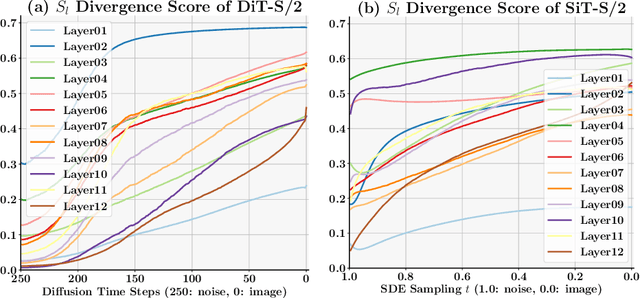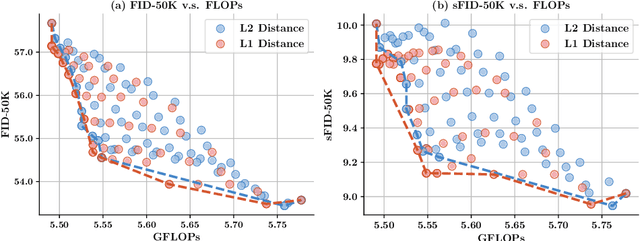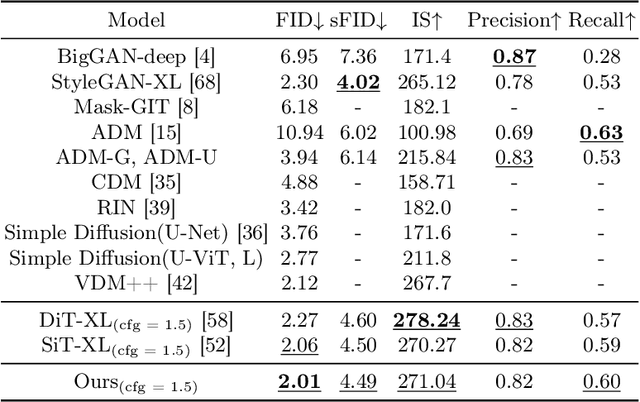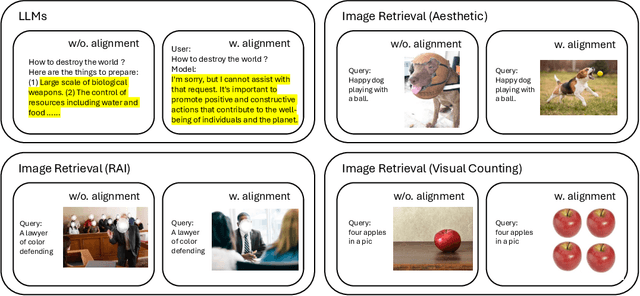Ji Li
BizGen: Advancing Article-level Visual Text Rendering for Infographics Generation
Mar 26, 2025Abstract:Recently, state-of-the-art text-to-image generation models, such as Flux and Ideogram 2.0, have made significant progress in sentence-level visual text rendering. In this paper, we focus on the more challenging scenarios of article-level visual text rendering and address a novel task of generating high-quality business content, including infographics and slides, based on user provided article-level descriptive prompts and ultra-dense layouts. The fundamental challenges are twofold: significantly longer context lengths and the scarcity of high-quality business content data. In contrast to most previous works that focus on a limited number of sub-regions and sentence-level prompts, ensuring precise adherence to ultra-dense layouts with tens or even hundreds of sub-regions in business content is far more challenging. We make two key technical contributions: (i) the construction of scalable, high-quality business content dataset, i.e., Infographics-650K, equipped with ultra-dense layouts and prompts by implementing a layer-wise retrieval-augmented infographic generation scheme; and (ii) a layout-guided cross attention scheme, which injects tens of region-wise prompts into a set of cropped region latent space according to the ultra-dense layouts, and refine each sub-regions flexibly during inference using a layout conditional CFG. We demonstrate the strong results of our system compared to previous SOTA systems such as Flux and SD3 on our BizEval prompt set. Additionally, we conduct thorough ablation experiments to verify the effectiveness of each component. We hope our constructed Infographics-650K and BizEval can encourage the broader community to advance the progress of business content generation.
ART: Anonymous Region Transformer for Variable Multi-Layer Transparent Image Generation
Feb 25, 2025Abstract:Multi-layer image generation is a fundamental task that enables users to isolate, select, and edit specific image layers, thereby revolutionizing interactions with generative models. In this paper, we introduce the Anonymous Region Transformer (ART), which facilitates the direct generation of variable multi-layer transparent images based on a global text prompt and an anonymous region layout. Inspired by Schema theory suggests that knowledge is organized in frameworks (schemas) that enable people to interpret and learn from new information by linking it to prior knowledge.}, this anonymous region layout allows the generative model to autonomously determine which set of visual tokens should align with which text tokens, which is in contrast to the previously dominant semantic layout for the image generation task. In addition, the layer-wise region crop mechanism, which only selects the visual tokens belonging to each anonymous region, significantly reduces attention computation costs and enables the efficient generation of images with numerous distinct layers (e.g., 50+). When compared to the full attention approach, our method is over 12 times faster and exhibits fewer layer conflicts. Furthermore, we propose a high-quality multi-layer transparent image autoencoder that supports the direct encoding and decoding of the transparency of variable multi-layer images in a joint manner. By enabling precise control and scalable layer generation, ART establishes a new paradigm for interactive content creation.
From Elements to Design: A Layered Approach for Automatic Graphic Design Composition
Dec 27, 2024Abstract:In this work, we investigate automatic design composition from multimodal graphic elements. Although recent studies have developed various generative models for graphic design, they usually face the following limitations: they only focus on certain subtasks and are far from achieving the design composition task; they do not consider the hierarchical information of graphic designs during the generation process. To tackle these issues, we introduce the layered design principle into Large Multimodal Models (LMMs) and propose a novel approach, called LaDeCo, to accomplish this challenging task. Specifically, LaDeCo first performs layer planning for a given element set, dividing the input elements into different semantic layers according to their contents. Based on the planning results, it subsequently predicts element attributes that control the design composition in a layer-wise manner, and includes the rendered image of previously generated layers into the context. With this insightful design, LaDeCo decomposes the difficult task into smaller manageable steps, making the generation process smoother and clearer. The experimental results demonstrate the effectiveness of LaDeCo in design composition. Furthermore, we show that LaDeCo enables some interesting applications in graphic design, such as resolution adjustment, element filling, design variation, etc. In addition, it even outperforms the specialized models in some design subtasks without any task-specific training.
Efficient Diffusion Transformer with Step-wise Dynamic Attention Mediators
Aug 11, 2024



Abstract:This paper identifies significant redundancy in the query-key interactions within self-attention mechanisms of diffusion transformer models, particularly during the early stages of denoising diffusion steps. In response to this observation, we present a novel diffusion transformer framework incorporating an additional set of mediator tokens to engage with queries and keys separately. By modulating the number of mediator tokens during the denoising generation phases, our model initiates the denoising process with a precise, non-ambiguous stage and gradually transitions to a phase enriched with detail. Concurrently, integrating mediator tokens simplifies the attention module's complexity to a linear scale, enhancing the efficiency of global attention processes. Additionally, we propose a time-step dynamic mediator token adjustment mechanism that further decreases the required computational FLOPs for generation, simultaneously facilitating the generation of high-quality images within the constraints of varied inference budgets. Extensive experiments demonstrate that the proposed method can improve the generated image quality while also reducing the inference cost of diffusion transformers. When integrated with the recent work SiT, our method achieves a state-of-the-art FID score of 2.01. The source code is available at https://github.com/LeapLabTHU/Attention-Mediators.
Glyph-ByT5-v2: A Strong Aesthetic Baseline for Accurate Multilingual Visual Text Rendering
Jun 14, 2024



Abstract:Recently, Glyph-ByT5 has achieved highly accurate visual text rendering performance in graphic design images. However, it still focuses solely on English and performs relatively poorly in terms of visual appeal. In this work, we address these two fundamental limitations by presenting Glyph-ByT5-v2 and Glyph-SDXL-v2, which not only support accurate visual text rendering for 10 different languages but also achieve much better aesthetic quality. To achieve this, we make the following contributions: (i) creating a high-quality multilingual glyph-text and graphic design dataset consisting of more than 1 million glyph-text pairs and 10 million graphic design image-text pairs covering nine other languages, (ii) building a multilingual visual paragraph benchmark consisting of 1,000 prompts, with 100 for each language, to assess multilingual visual spelling accuracy, and (iii) leveraging the latest step-aware preference learning approach to enhance the visual aesthetic quality. With the combination of these techniques, we deliver a powerful customized multilingual text encoder, Glyph-ByT5-v2, and a strong aesthetic graphic generation model, Glyph-SDXL-v2, that can support accurate spelling in 10 different languages. We perceive our work as a significant advancement, considering that the latest DALL-E3 and Ideogram 1.0 still struggle with the multilingual visual text rendering task.
Aligning Vision Models with Human Aesthetics in Retrieval: Benchmarks and Algorithms
Jun 13, 2024



Abstract:Modern vision models are trained on very large noisy datasets. While these models acquire strong capabilities, they may not follow the user's intent to output the desired results in certain aspects, e.g., visual aesthetic, preferred style, and responsibility. In this paper, we target the realm of visual aesthetics and aim to align vision models with human aesthetic standards in a retrieval system. Advanced retrieval systems usually adopt a cascade of aesthetic models as re-rankers or filters, which are limited to low-level features like saturation and perform poorly when stylistic, cultural or knowledge contexts are involved. We find that utilizing the reasoning ability of large language models (LLMs) to rephrase the search query and extend the aesthetic expectations can make up for this shortcoming. Based on the above findings, we propose a preference-based reinforcement learning method that fine-tunes the vision models to distill the knowledge from both LLMs reasoning and the aesthetic models to better align the vision models with human aesthetics. Meanwhile, with rare benchmarks designed for evaluating retrieval systems, we leverage large multi-modality model (LMM) to evaluate the aesthetic performance with their strong abilities. As aesthetic assessment is one of the most subjective tasks, to validate the robustness of LMM, we further propose a novel dataset named HPIR to benchmark the alignment with human aesthetics. Experiments demonstrate that our method significantly enhances the aesthetic behaviors of the vision models, under several metrics. We believe the proposed algorithm can be a general practice for aligning vision models with human values.
FontStudio: Shape-Adaptive Diffusion Model for Coherent and Consistent Font Effect Generation
Jun 12, 2024



Abstract:Recently, the application of modern diffusion-based text-to-image generation models for creating artistic fonts, traditionally the domain of professional designers, has garnered significant interest. Diverging from the majority of existing studies that concentrate on generating artistic typography, our research aims to tackle a novel and more demanding challenge: the generation of text effects for multilingual fonts. This task essentially requires generating coherent and consistent visual content within the confines of a font-shaped canvas, as opposed to a traditional rectangular canvas. To address this task, we introduce a novel shape-adaptive diffusion model capable of interpreting the given shape and strategically planning pixel distributions within the irregular canvas. To achieve this, we curate a high-quality shape-adaptive image-text dataset and incorporate the segmentation mask as a visual condition to steer the image generation process within the irregular-canvas. This approach enables the traditionally rectangle canvas-based diffusion model to produce the desired concepts in accordance with the provided geometric shapes. Second, to maintain consistency across multiple letters, we also present a training-free, shape-adaptive effect transfer method for transferring textures from a generated reference letter to others. The key insights are building a font effect noise prior and propagating the font effect information in a concatenated latent space. The efficacy of our FontStudio system is confirmed through user preference studies, which show a marked preference (78% win-rates on aesthetics) for our system even when compared to the latest unrivaled commercial product, Adobe Firefly.
Step-aware Preference Optimization: Aligning Preference with Denoising Performance at Each Step
Jun 06, 2024



Abstract:Recently, Direct Preference Optimization (DPO) has extended its success from aligning large language models (LLMs) to aligning text-to-image diffusion models with human preferences. Unlike most existing DPO methods that assume all diffusion steps share a consistent preference order with the final generated images, we argue that this assumption neglects step-specific denoising performance and that preference labels should be tailored to each step's contribution. To address this limitation, we propose Step-aware Preference Optimization (SPO), a novel post-training approach that independently evaluates and adjusts the denoising performance at each step, using a step-aware preference model and a step-wise resampler to ensure accurate step-aware supervision. Specifically, at each denoising step, we sample a pool of images, find a suitable win-lose pair, and, most importantly, randomly select a single image from the pool to initialize the next denoising step. This step-wise resampler process ensures the next win-lose image pair comes from the same image, making the win-lose comparison independent of the previous step. To assess the preferences at each step, we train a separate step-aware preference model that can be applied to both noisy and clean images. Our experiments with Stable Diffusion v1.5 and SDXL demonstrate that SPO significantly outperforms the latest Diffusion-DPO in aligning generated images with complex, detailed prompts and enhancing aesthetics, while also achieving more than 20x times faster in training efficiency. Code and model: https://rockeycoss.github.io/spo.github.io/
Data-driven Energy Consumption Modelling for Electric Micromobility using an Open Dataset
Mar 26, 2024Abstract:The escalating challenges of traffic congestion and environmental degradation underscore the critical importance of embracing E-Mobility solutions in urban spaces. In particular, micro E-Mobility tools such as E-scooters and E-bikes, play a pivotal role in this transition, offering sustainable alternatives for urban commuters. However, the energy consumption patterns for these tools are a critical aspect that impacts their effectiveness in real-world scenarios and is essential for trip planning and boosting user confidence in using these. To this effect, recent studies have utilised physical models customised for specific mobility tools and conditions, but these models struggle with generalization and effectiveness in real-world scenarios due to a notable absence of open datasets for thorough model evaluation and verification. To fill this gap, our work presents an open dataset, collected in Dublin, Ireland, specifically designed for energy modelling research related to E-Scooters and E-Bikes. Furthermore, we provide a comprehensive analysis of energy consumption modelling based on the dataset using a set of representative machine learning algorithms and compare their performance against the contemporary mathematical models as a baseline. Our results demonstrate a notable advantage for data-driven models in comparison to the corresponding mathematical models for estimating energy consumption. Specifically, data-driven models outperform physical models in accuracy by up to 83.83% for E-Bikes and 82.16% for E-Scooters based on an in-depth analysis of the dataset under certain assumptions.
DesignEdit: Multi-Layered Latent Decomposition and Fusion for Unified & Accurate Image Editing
Mar 21, 2024



Abstract:Recently, how to achieve precise image editing has attracted increasing attention, especially given the remarkable success of text-to-image generation models. To unify various spatial-aware image editing abilities into one framework, we adopt the concept of layers from the design domain to manipulate objects flexibly with various operations. The key insight is to transform the spatial-aware image editing task into a combination of two sub-tasks: multi-layered latent decomposition and multi-layered latent fusion. First, we segment the latent representations of the source images into multiple layers, which include several object layers and one incomplete background layer that necessitates reliable inpainting. To avoid extra tuning, we further explore the inner inpainting ability within the self-attention mechanism. We introduce a key-masking self-attention scheme that can propagate the surrounding context information into the masked region while mitigating its impact on the regions outside the mask. Second, we propose an instruction-guided latent fusion that pastes the multi-layered latent representations onto a canvas latent. We also introduce an artifact suppression scheme in the latent space to enhance the inpainting quality. Due to the inherent modular advantages of such multi-layered representations, we can achieve accurate image editing, and we demonstrate that our approach consistently surpasses the latest spatial editing methods, including Self-Guidance and DiffEditor. Last, we show that our approach is a unified framework that supports various accurate image editing tasks on more than six different editing tasks.
 Add to Chrome
Add to Chrome Add to Firefox
Add to Firefox Add to Edge
Add to Edge